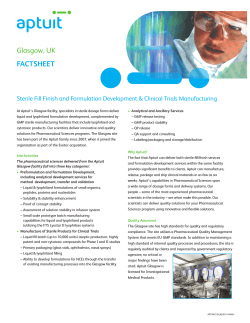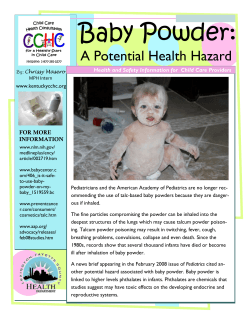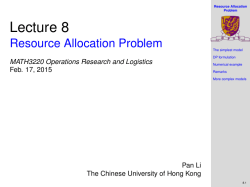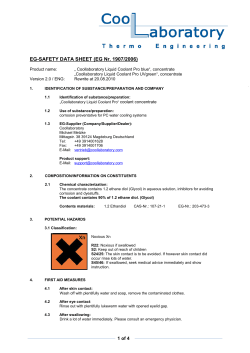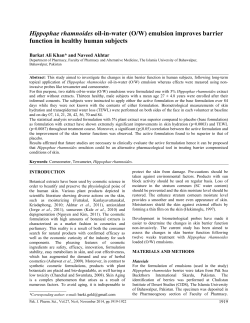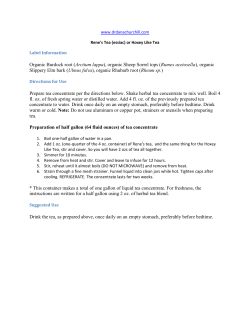
Formulation of chemical (and biological) pesticides Why formulate?
Why formulate? Formulation of chemical (and biological) pesticides • Make pesticide easy to use • optimise performance • increase stability in storage Biology-based Chemical Control Methods 2012 RPB : Formulation: v. 3.0 A household example of a formulation Shampoo • sodium lauryl sulphate • cocamidopropyl betaine • sodium chloride • citric acid • sodium EDTA • formaldehyde • dye CI 15935 • water >40 standard pesticide Formulations … Terminology (CropLife International*) anionic surfactant neutral surfactant ionic strength adjuster pH adjuster complexer (shelf life) bacteriostat colouring agent filler 2-letter convention: e.g. EC, WP … starting with: AI - Active Ingredient TC - Technical material * formerly GIFAP then GCPF go to Catalogue of Pesticide Formulation Types (Monograph 2): http://www.croplife.org/monographs.aspx Formulation components Some common formulations Formulation types by use Dry DP GR Applied as liquid sprays: The active ingredient (a.i.) Usually used undiluted (or limited dilution with organic carrier) MG Formulations for baiting ULV UL, OF Seed treatments Fogging: HN, KN Fumigants and smokes Miscellaneous others PO - pour on (animals) GS - grease etc. For mixing and spraying with water SL, SP WP EC SC WG For activity: • solvents • compatibility agents • anti-evaporants • humectants • anti-oxidants • UV screens • wetters • stickers • herbicide absorption • herbicide enhancers • other synergists • bacteriostats For safety: • warning colours • stenches • bittering agents • emetics Water miscible formulations Older formulations: Emulsifiable concentrate Wettable powder Soluble (liquid) concentrate Soluble powder Solutions EC WP SL SP water-miscible concentrate SL active ingredient 250 g/L (e.g. glyphosate ester herbicide) cationic surfactant 20 g/L ethylene glycol 100 g/L anti-oxidant 5 g/L water to 1 L Reducing hazards (and use of solvents), improved stability: Suspension concentrate SC Capsule suspensions CS Water dispersible granules WG Micro-emulsions ME Suspensions and Emulsions emulsifiable concentrate micro-emulsion Composition of a basic EC EC ME emulsifier [smaller oil globules: improved suspensibility] oil a.i. solvent Formulation compounds Examples of solvents water phyto miscible -toxic user hazard Emulsification (CH3)3C flash point dissolving power (a.i) C(CH3)3 O C(CH3)3 O O O O O OH typical surfactant (e.g. non-ionic) yes Alcohols (e.g. methanol) low low low low glycols low low high mid no Aromatics (xylene, iranolin) low -high high low -mid high Ideal solvent yes low low high high yes Polar Hydrophilic end Lipophilic end High shear blender Oil globules in water Water-soluble sachets Water-miscible Powders wettable powders water soluble powder water-dispersible granules WP SP WG [easy to handle / no dust / free-flowing … but more expensive] Safety advantages of sachets: reduced contact between operator and formulation Composition of a typical WP inert filler a.i. dispersing agent Suspension concentrate SC no dust, easier handling than WP For example: active ingredient * 600 g/L non-ionic surfactant 50 g/L bentonite (gelling agent) 8 g/L ethylene glycol 50 g/L benzoic acid (bacteriostat) 0.5 g/L water to 1 L * milled to a fine particle size - suspensibility Maintaining particles in suspension Stokes’ Law (spherical particles): u (terminal velocity of particle) = g d2 ∂ρ _________ 18 η where: g is 9.81 m s-1 d is the inclusion diameter [m] ∂ρ is the difference in densities between the ambient liquid and the particle [kg m-3], and η is the liquid viscosity [N s m-2] Capsule suspension CS Micro-encapsulation: Can separate reactive components reduced volatility/flamability reduced iritant handling hazards….. Seed treatments Flowable concentrate for seed treatment Emulsion for seed treatment Solution for seed treatment FS ES LS Granules and Dusts dustable powder micro-granules DP MG granules GR [easy to handle/ no dust/ slow release] Toxic granule formulation (‘Temik’ GR) see: http://www.bayercropscience.co.uk/output.aspx?sec=414&con=391 Formulations for small droplets… Hot fogging concentrate HN Cold fogging concentrate KN Aerosol dispenser AE Smokes Smoke cartridge FP [also smoke candles etc.] • warehouses • greenhouses • grain silos Spreading oil Baits bait (ready for use) block bait etc… SO RB BB … also Contact (tracking) powder CP Adjuvants … not active themselves, but enhance pesticidal action acting as … References on Formulations General • • • • anti-evaporants stickers compatibility agents herbicide absorption enhancers • humectants • wetters • synergists Both: Kluwer (1998) For biopesticides Biopesticides Bacillus thuringiensis (B.t.) products • Maintaining biological activity in hostile environments … • …mitigating the effects of solar radiation • Interactions with production systems • Stability and quality control • … maintaining viability of agent • Most important sector of biopesticide market • Products often similar to chemicals … • … but are bacteria alive? Ultra-low volume (ULV) application oil-based solution for ULV suspension for ULV Biopesticide formulation issues: UL and OF formulations UL SU structuring agent inert a.i. dispersing agent a.i. a.i. oil Technical malathion oil-miscible flowable concentrate solvent OF OF - dimilin (an insect growth regulator) - mycoinsecticides Summary Wide range (>40) of pesticide formulations Main issues for formulator: • method of application • properties of a.i. • biological activity • mode of action • safety in use • formulation costs • market preference oil UL Q: what type of formulation would you develop for... • a rodenticide for use on farms? • an irritating compound for spraying? • an insecticide for disinfestation of glasshouses at end of season? • high volume treatment of a cereal crop with a non-soluble pesticide? • an aerially applied locust insecticide?
© Copyright 2025

